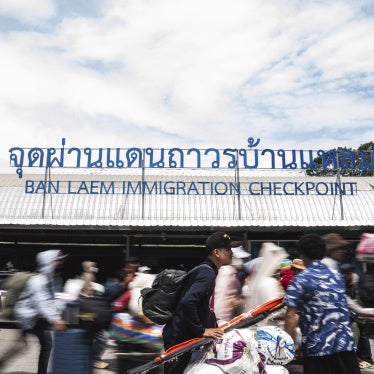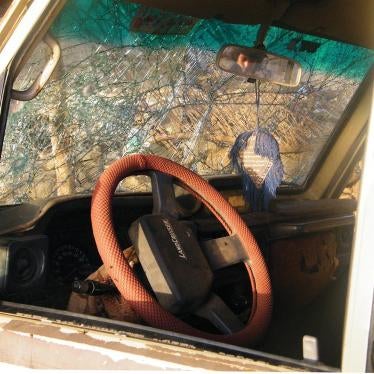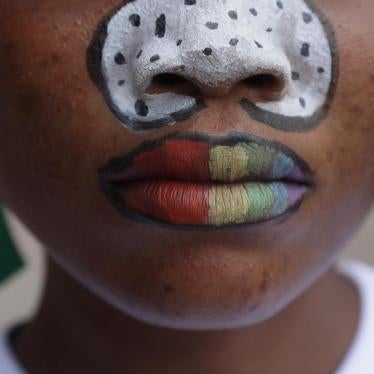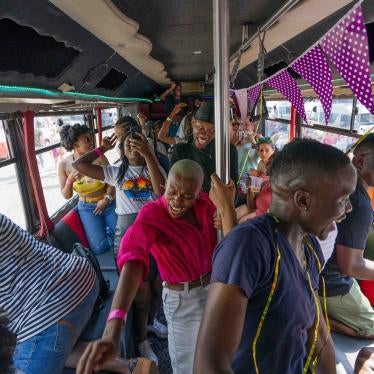Unlike fishing boats elsewhere, the small, graceful wooden vessels that are grounded all day on the sandy beach at Sonarpara, 400 kilometers (250 miles) southeast of Dhaka, are heavy with cargo when they set out to sea at night and empty when they return to shore. Yet they still make a profit, for their business is not fishing but human trafficking. For tens of thousands of migrants and asylum-seekers, the boats are the first leg of a desperate journey from Bangladesh to Malaysia and beyond.
According to survivors and family members we interviewed on a recent Human Rights Watch visit to the area, those boarding the boats are almost equally divided between poverty-stricken Bengalis and even more destitute Rohingya. Whereas the former arrive from all corners of Bangladesh as economic migrants, the stateless Rohingya are fleeing ethnic violence and discrimination. For many Rohingya, the journey started on the other side of the border in neighboring Myanmar (also known as Burma).
The Rohingya have long been despised and persecuted in Myanmar, where the government effectively denies them citizenship and the rights that come with it, excludes them from the census, and even rejects any reference to the word Rohingya. At the same time, the authorities have failed to address, if not actively promoted, Buddhist extremist violence against the predominantly Muslim minority group.
In Bangladesh, the Rohingya are barely tolerated; only 32,800 of an estimated 200,000 to 500,000 who entered the country in the early 1990s are recognized as refugees and afforded minimal protection in two refugee camps administered by the United Nations High Commissioner for Refugees (UNHCR). The rest have no opportunity to lodge refugee claims in Bangladesh. It is little wonder then that so many are choosing to risk their lives in the hope of a better future elsewhere.
Yet several of the survivors we interviewed gave harrowing accounts of how what began as a risky but voluntary migration became a coerced human trafficking operation. Migrants are often held for huge ransoms and physically abused until family members come up with the money to pay for their release.
“My family had to sell its cattle,” said Mohammed Alam, 21. It has been two years since he returned penniless to Sonarpara, after spending 19 days at sea on a trawler with 420 other people on board before being held hostage in southern Thailand for 17 days until his family paid 170,000 taka (about $2,200). He only volunteered to speak after other survivors had done so, finding some comfort in the fact that his story was not unusual.
THE ANDAMAN SEA INC. PIPELINE
The migrants begin their journeys in camps at Sonarpara, where they are held, sometimes for days, until the weather is good enough and there are enough people gathered to maximize profits. Under cover of night, the migrants are herded onto fishing boats in groups of 25 or so—and they usually embark thinking this is the beginning of the end to their misery. Anywhere from half-a-day to two days later, these rickety boats reach larger trawlers awaiting the human cargo in international waters.
The trawlers, manned by “crews” of 13 to 17 armed men according to witness accounts, are crammed with as many as 500 migrants. Mohammed Alam and Shah Alam, 27, two unrelated Bengalis who survived the onward journey, spent 17 and 19 days, respectively, on trawlers and then reached Thailand, not Malaysia as they had been promised. Dehydration, starvation, exhaustion, and the lack of sanitation take a toll on many. This was the case with Afaz-ud-din, 17, who became gravely ill at sea and died, his uncle told us. It should come as no surprise that dozens of decomposed bodies have washed ashore in Bangladesh and Myanmar.
Others spend even longer at sea, victims of the inhumane maritime “ping-pong” that Indonesia, Malaysia, and Thailand play with the trawlers to keep them away from their shores in international waters. Instead of conducting search-and-rescue operations, these governments drive the trawlers further out to sea, at times providing them with fuel, and in the best cases with some water. In doing so, they are violating their international obligation to provide assistance to people in distress at sea. Mohamad Ismail told us he drifted all the way to Laban Island, off the southern coast of Sumatra, Indonesia, with 500 others on a trawler. The “crew” had jumped ship after a patrol boat from Malaysia spotted the trawler, leaving the helpless migrants on board at the mercy of the currents. “I lost half my body weight,” Mohamad recounted. “We thought we are all going to die, starving.”
The migrants leaving from Sonarpara had all paid roughly 5,000 takas ($64) for the journey to Malaysia. Yet upon arriving in Thailand, they were handed over to armed traffickers who held them for ransom. Some told us that entire boatloads were taken inland, deep into the jungle, and forced to hike steep limestone cliffs to makeshift detention camps.
“After wading through a coastal swamp, we entered a deep river valley escorted by armed men,” one survivor told me. “Several hours later we reached a vertical rock wall that we had difficulty hiking to arrive at a large cave.” None of those we interviewed could identify the mountain hideout, beyond giving the colloquial name Sheel Bahar (Stone Mountain). At the camp, the survivors saw traces of people who had earlier passed through.
“There were pieces of cloth, slippers. Some people had carved their initials on the rock,” Ahmed Hussein, 30, told us. “It was very frightening, because by then we knew that we were hostages, that we might be killed.”
There the migrants are threatened, and sometimes beaten, by the armed traffickers until they place mobile calls to their family asking for an additional 150,000–180,000 takas ($1,900–$2,300) in exchange for their freedom. Ironically, a phone banking system to support access to remittances from relatives working abroad has become the method of choice for collecting ransoms. The amount is normally deposited in fake accounts set up under the names of ordinary villagers who are often unaware of the large sums deposited in their names, allowing the traffickers to cover their financial tracks.
Families that are not forthcoming with the money get additional calls to hear the pleading and screaming of tortured migrants, which sometimes goes on over many weeks. “I saw them beating the most penniless,” Shah told me. Families that manage to collect the ransom money frequently do so by selling or mortgaging their few possessions, indenturing family members, or worse. The recent discovery of several mass graves on both sides of the Malaysia–Thailand border gives some indication of what happens to those who are unable to pay. Some survivors claimed to have seen “dead bodies in the jungle,” along the trail leading to Malaysia.
If the ransom money is paid, the migrants are taken to the border with Malaysia, which is about a day’s journey away by foot. “Once we were freed we were taken through the mountainous jungle to a lookout from which we could see palm oil plantations afar. From there we eventually reached Alor Setar,” capital of the northwestern state of Kedah, Malaysia, another told me.
A TRANSNATIONAL ENTERPRISE
It’s unclear who is behind the human trafficking. During our visit, many migrants gave us the same names for those believed to run the local trafficking operation. A member of parliament with an alleged family history of smuggling was repeatedly mentioned. We cannot determine whether this is true or false, and Prime Minister Sheikh Hasina’s disparaging description of migrants as “mentally sick” is not conducive to prosecutions or criminal investigations. Likewise, her increasingly authoritarian tendencies have done much to weaken the rule of law.
But the trafficking operation is not restricted to Bangladesh. It is a transnational enterprise that includes criminal elements from all neighboring countries. Often, the guards on the trawlers that carry the migrants away from the coast are Burmese. Then the human cargo is handed over to Thai networks, before Malaysians receive them for the final leg. Several sources we interviewed singled out the city of Penang, Malaysia, some 200 kilometers (125 miles) south of the Thailand–Malaysia border, as the center of operations for human trafficking in the Andaman Sea.
And the operation benefits from the complicity of a host of corrupt officials in the origin, transit, and destination countries. The corruption begins on the coast of Bangladesh, where we saw border guard pickets close to the beach—they apparently get a cut based on the headcount. Several survivors we interviewed also described encounters with the police in Thailand, who, far from providing protection, were clearly in the pocket of the traffickers. One even told us of a three-day-long captivity in a police post, before being loaded like cattle onto tarpaulin-covered trucks destined for a remote detention camp in the jungle.
These accounts corroborated what Human Rights Watch had already found elsewhere: The camps, and the brutality inflicted on people there, are hardly a secret on either side of the border.
“There were four heavily armed guards with us, and others in lookouts all around us,” said one unnamed survivor. “I think about 13 or 14 in total, mostly Thai. We were held in caves.” After 17 days at sea, he too had been off-loaded in southern Thailand and taken hostage along with 500 others. “We had no roof out in the jungle. We were fed rice and dried fish once a day, awaiting our release.” Some fell very ill, such as Nur Mohammed, 28, whose body bloated for days yet who miraculously managed to survive, thanks to his brother-in-law’s care.
All the survivors and family members of missing migrants we met shared two things: their point of departure from Sonarpara and the desire to tell their stories. Among the survivors, none indicated a willingness to embark and risk their lives again. Yet with the monsoon season coming to an end, the boats at Sonarpara will take to the seas in increasing numbers, laden with migrants and asylum seekers. Some sources believe the sea routes have become weather-proof and now operate all-year-round. Others contend that the risk of losing trawlers, not the cargo, in the stormy high seas is what makes the industry somewhat seasonal. What remains certain is that there are still tens, if not hundreds, of thousands of destitute Bengalis and desperate Rohingya to keep the industry going, despite all the risks associated with falling prey to the traffickers of Andaman Sea Inc.
Although the Bangladeshi prime minister has said that “there is sufficient work” and that the migrants “could have better lives” in Bangladesh, this seems unlikely for the unwanted and undocumented Rohingya. The government could start by issuing them identity documents and allowing them to work legally instead of worrying about them“tainting the image of the country.”
In fact, the government is quite happy to accept the remittances if the migrants’ journeys end in success, and is glad to be rid of the Rohingya, an added burden on a country already dealing with overpopulation and underdevelopment. Without a clear signal from Hasina, it seems unlikely that the strong anti-trafficking legislation already in place in Bangladesh will be used to deter the trade.
Yet despite Bangladesh’s failure to address the grave threats to the Rohingya, their situation in neighboring Myanmar is even more desperate. In recent years they have been subjected to “ethnic cleansing,” resulting in crimes against humanity. Tens of thousands of Rohingya homes have been burned to the ground.
When representatives from 17 countries and various UN and regional agencies met in Bangkok in May to address the migrant situation in the Andaman Sea, however, the final statement made no reference to the Rohingya. In fact, the only mention during the entire summit was by government officials from Myanmar, who warned other delegates not to use the term Rohingya. They have become invisible to many, making them increasingly vulnerable to more aggressive trafficking gangs.
The Southeast Asian nations, and the international community more widely, should demand that Bangladesh and Myanmar immediately end discrimination and persecution of the Rohingyas. Indonesia, Malaysia, and Thailand need to conduct search-and-rescue operations at sea, cease maritime pushbacks, bring the trawlers ashore, provide desperately needed humanitarian aid, and give full access to procedures for international protection and resettlement of refugees and asylum-seekers in close coordination with UNHCR. In addition, Malaysia and Thailand need to redouble efforts to intercept the human trafficking networks on land and to close the detention camps near the border.
The stories of human trafficking in the Andaman Sea currently have few happy endings. Two weeping mothers we met who are searching for their lost sons have had no news of their whereabouts since they embarked from Sonarpara two years ago. One was disconsolate because she had not brought pictures of her son to share with us, unlike most of the other family members of missing migrants. Jamal Hussein, who symbolically buried his 23-year-old son after he went missing, has heard news that his son may be alive after all in Malaysia. Hussein desperately clings to that hope, and to the wrinkled photocopies of his identity papers.
With international attention fixed for now on the refugees and asylum seekerscrossing the Mediterranean Sea and the Balkans, “business” in the Andaman Sea is likely to continue undisturbed. And the hope of a better life among the most destitute and fearful will, at least for the foreseeable future, keep that business profitable.








